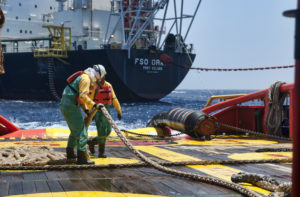A detailed study has been published by HR Wallingford in collaboration with OCIMF that support stakeholders in making their own assessments to determine suitable weather criteria and ascertain an appropriate weather window for STS operations
Due to extensive development and maturation of mooring line load simulation technology and software programmes in recent years means that equipment and tools are now available to re-assess and re-validate the previous studies.
The aforementioned study supports the KPIs listed under Element 5 of STS Service Provider Management and Self-Assessment. Additional, can be used to do location specific risk assessment and to determine safe operating environment limits, and a suitable weather window for ship to ship cargo transfer operations.
The STS study methodology based on a full dynamic mooring assessment and has been adopted in deriving mooring thresholds for STS operations for a range of ship type combinations, from coastal tankers to VLCCs, both underway and at anchor. More specific the following attributes are included:
-The interaction between the real position of the vessels, their velocity and inertia, and the waves and moorings 
-Resonance effects
-The principal forces acting on moored ships, such as from swell, long period waves, second order waves, wind and current (vessel water speed)
-The effects of shallow water and the associated additional weight of entrained water when the vessel moves (added mass)
-Roll can be exaggerated in computational ship mooring models, especially quartering to beam seas.
-The models have been calibrated against other model results (both physical and numerical) and from site measurements, and in particular for side-by-side moored/double-banked ships
-In the case of STS operations, the coupling effects between the two vessels are included
The dynamic mooring assessment can be used to determine statistics of line and fender loads, as well as vessel motions (and relative motions) in surge, sway, heave, roll, pitch and yaw.
Source: https://www.ocimf.org
Contact us to receive a professional advisory in your area of interest
